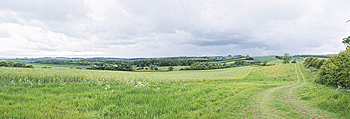Win CENS ProFlex DX5 earplugs worth £1,149 – enter here
Stewardship: Scheme for success
<strong>Advice on how to get hold of HLS money</strong>

We are incredibly lucky in this country to have such a good Stewardship Scheme, and Natural England should be praised for having consulted so widely when the scheme was put together. The basic Entry Level Scheme (ELS) has been taken up on more than three quarters of England?s farms and has resulted in many good things happening on the ground, despite critical newspaper and magazine articles.
The Higher Level Scheme (HLS) is a competitive, more targeted scheme that complements the ELS, but allows farmers to go further with their conservation plans and really delivers what is needed so badly for wildlife in the wider countryside.
So, with such great schemes available, why the critical response? The Government made a great song and dance about ring-fencing the money going into the schemes soon after it was elected and it does seem to have largely achieved its aims. However, the HLS now appears to be incredibly hard to get into and if you do manage to get accepted, be prepared for your application plan to be quite severely back ?cropped?.
In other words, you might well have plans to clean out a pond or create a new one, plant a new hedge or small copse, but unless you are in a ?special area?, your chances are slim at best.
Nick Rowsell, a Hampshire farmer and keen conservationist who also chairs the Campaign for the Farmed Environment within the county, is one such farmer who cannot get into the HLS. His old-style Countryside Stewardship Scheme, through which the Government has paid him for the past 10 years to manage various habitats across the farm, finished in September. But apparently, his farm is now not ?good enough? to be selected to enter the HLS, so he has been informed that he should not bother putting in an application.
What has changed in Government thinking to make this farm fall out of favour and who is going to tell the wildlife that unfortunately it is not (yet)
rare enough to warrant special attention, even though it was in the past? Nick said, ?It?s not just the wildlife that suffers either. As part of my old Stewardship scheme, I had put in permissive footpaths across the farm for local villagers to use and they have proved to be very popular. It has now put me in a difficult position trying to explain to them that I am going to have to take some of them out as I get no reimbursement for them any longer.?
Yet another public relations disaster in the making for the farming industry, but as is often the case, not one of its creation. Let me now take you eight miles due west of Nick?s farm to the Middleton estate owned by Richard Wills.
Richard is a keen shooting man and is highly enthusiastic about re-stablishing a healthy wild grey partridge population once again. His application to the HLS scheme was successful and he is planting lots of wild bird seed mixes, beetle banks and brood-rearing strips across the farm. And ? guess what ? numbers of partridge have indeed soared.
Chris Hewitt, Richard?s estate manager, says, ?We are now in our third year of HLS and the scheme is running very smoothly. We had bird surveys done of the farm, so we knew that some key farmland species were present and we also have some important wet woodland and fen habitats. It was a relatively straightforward application ? they seemed keen to have us on board.?
Now, I fully understand the fact that Natural England, which oversees the Stewardship Schemes in England, has to make sure that the money they spend is money well spent, especially when funds are being squeezed.
However, the ordinary farmer contemplating going into HLS for the first time or thinking that he or she will be able to ?roll over? their old Stewardship scheme into a new one, should be made aware of the statement on the Government?s own website, which reads as follows:
Natural England has considerably changed the way in which it works with farmers on HLS agreements over the past few years. We have gone from a reactive approach, using very broad scheme targets, to a proactive approach based upon more than 100 target areas where HLS objectives are specially concentrated, plus other agreements for important features such as farmland birds outside these target areas.
In other words, Government has decided to spend available money on the most important habitats at the cost of ?ordinary? countryside, unless you happen to have some rare birds present.
However, what I find at odds with this statement is that the Government published its own White Paper on the future of the Environment in June 2011, which was in response to professor Sir John Lawton?s review Making space for nature, in which he found that nature in England is highly fragmented and unable to respond effectively to new pressures, such as climate and population change.
On the back of this, the England Biodiversity group, represented by the conservation, land-owning and farming communities together with statutory agencies, collectively wrote their ThinkBIG report, which stated:
First, we need to be thinking and acting at a much larger scale. We can no longer focus our efforts on preserving and maintaining individual wildlife sites, important as these are. We need to look beyond these sites at the wider environment in our towns,cities and countryside.
So, which is it ? 100 targeted HLS areas or the wider countryside ? such as Nick?s farm? Surely now is the time to really grasp this issue of integrating conservation and modern intensive farming if we are to tackle the issues that the Lawton report so clearly spelt out.
At the Game & Wildlife Conservation Trust, we understand fully through the research on our own farm at the Allerton project in Loddington, Leicestershire, that these two aspirations can certainly go hand in hand.
The farming business can be profitable and the wildlife and game can flourish.
However, this double success is dependent on sensibly costed grants being widely available across the whole countryside ? not just in favoured spots.
I am aware that times are tough, but if we are to keep our English countryside a ?green and pleasant land? full of wildlife, while still feeding the ever-growing human population, we need to think long term, not dip our toe in and out as and when it takes our fancy.
Now is the time to change radically the way that farms are subsidised out of the public purse, so that habitats and the wildlife that depend on them are not some rare luxurious attachment, but a properly funded part of managing any given piece of countryside.
As Lawton put it, ?We want more, bigger, better and joined!?
Related Articles
Get the latest news delivered direct to your door
Subscribe to Shooting Times & Country
Discover the ultimate companion for field sports enthusiasts with Shooting Times & Country Magazine, the UK’s leading weekly publication that has been at the forefront of shooting culture since 1882. Subscribers gain access to expert tips, comprehensive gear reviews, seasonal advice and a vibrant community of like-minded shooters.
Save on shop price when you subscribe with weekly issues featuring in-depth articles on gundog training, exclusive member offers and access to the digital back issue library. A Shooting Times & Country subscription is more than a magazine, don’t just read about the countryside; immerse yourself in its most authoritative and engaging publication.







